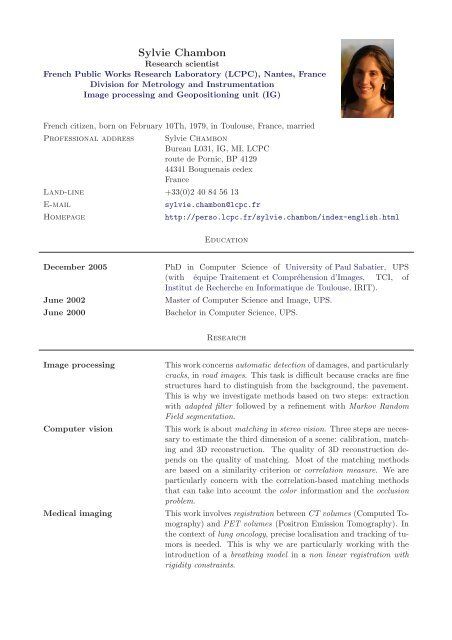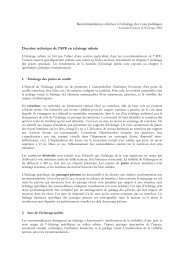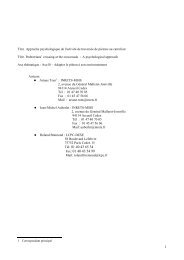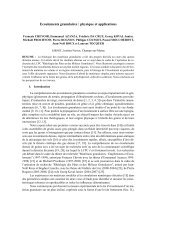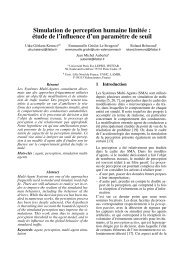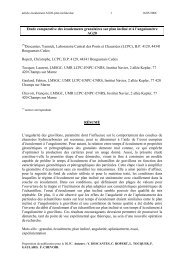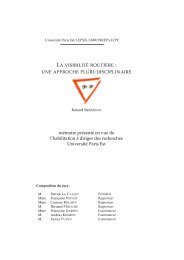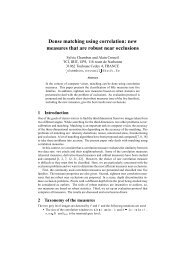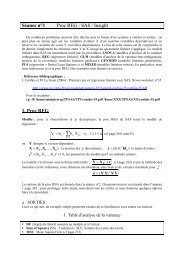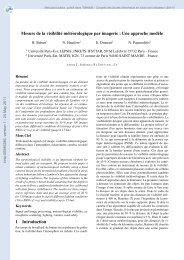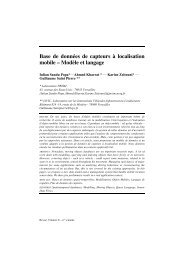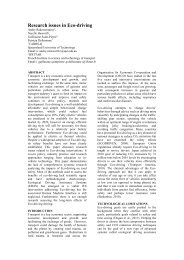CV - Pages perso - LCPC
CV - Pages perso - LCPC
CV - Pages perso - LCPC
- No tags were found...
Create successful ePaper yourself
Turn your PDF publications into a flip-book with our unique Google optimized e-Paper software.
Sylvie ChambonResearch scientistFrench Public Works Research Laboratory (<strong>LCPC</strong>), Nantes, FranceDivision for Metrology and InstrumentationImage processing and Geopositioning unit (IG)French citizen, born on February 10Th, 1979, in Toulouse, France, marriedProfessional addressSylvie ChambonBureau L031, IG, MI, <strong>LCPC</strong>route de Pornic, BP 412944341 Bouguenais cedexFranceLand-line +33(0)2 40 84 56 13E-mailHomepagesylvie.chambon@lcpc.frhttp://<strong>perso</strong>.lcpc.fr/sylvie.chambon/index-english.htmlEducationDecember 2005June 2002June 2000PhD in Computer Science of University of Paul Sabatier, UPS(with équipe Traitement et Compréhension d’Images, TCI, ofInstitut de Recherche en Informatique de Toulouse, IRIT).Master of Computer Science and Image, UPS.Bachelor in Computer Science, UPS.ResearchImage processingComputer visionMedical imagingThis work concerns automatic detection of damages, and particularlycracks, in road images. This task is difficult because cracks are finestructures hard to distinguish from the background, the pavement.This is why we investigate methods based on two steps: extractionwith adapted filter followed by a refinement with Markov RandomField segmentation.This work is about matching in stereo vision. Three steps are necessaryto estimate the third dimension of a scene: calibration, matchingand 3D reconstruction. The quality of 3D reconstruction dependson the quality of matching. Most of the matching methodsare based on a similarity criterion or correlation measure. We areparticularly concern with the correlation-based matching methodsthat can take into account the color information and the occlusionproblem.This work involves registration between CT volumes (Computed Tomography)and PET volumes (Positron Emission Tomography). Inthe context of lung oncology, precise localisation and tracking of tumorsis needed. This is why we are particularly working with theintroduction of a breathing model in a non linear registration withrigidity constraints.
Research projectsDecember 2007September 2006April 2007April 2006Automatic detection of cracks of the roadsIn the context of automatic detection of cracks in road images, these methodshave been developed: thresholding, using morphological tools, neuron networksand wavelet transform combined with Markov random field-based segmentation.The last category allows robustness to the size of the cracks. However,existing methods do not take into account 2D adapted filter and use a constantfunction for the crack modelling. It is not realistic. With the collaboration ofPeggy Subirats, at the Centre d’Études Techniques de l’Équipement (CETE),Rouen, France, improvements have been proposed to model a 2D adapted filterand a new designing of the sites of the Markov random field. This work willbe published in [4].Matching by propagation of seedsGlobal matching methods are efficient because they take into account globalconstraints and, so, for example, they can alleviate the problem of untexturedareas on the contrary of local matching methods. A lot of global methods arebased on an first partial matching of point of interest. Detect and select thesepoints is important for the performance of these methods. We are working onglobal methods based on seeds correspondences. These seeds are determinedwith the disparity map obtained by a local matching method (one of the robustmatching methods proposed in the thesis work). This work is realisedin collaboration with Alain Crouzil, at the university of Paul Sabatier, inToulouse and a master student Guillaume Galès.Color global matchingGlobal matching methods with dynamic programming or graph cuts are verypopular and give good results (see the evaluation protocol of Scharstein andSzeliski :http://bj.middlebury.edu/~schar/stereo/newEval/php/results.php).Actual methods do not take into account color and the aim of this workwith Michael Bleyer, researcher at Institute for Software Technology andInteractive Systems, in Interactive Media Systems, Vienna, en Austria, is tointroduce methodologies for adapting global methods to color and to proposean evaluation protocol in order to compare different global methods withcolor. This work has been first published in [5].Generalised Thin-Plate SplineThin-Plate Spline, TPS, are useful for modelling deformation between twoscenes composed of deformable objects. These methods, based on TPS, arenot rigid, i.e. they do not respect the epipolar constraint, and, consequently,they can not model perspective deformations. Three new TPS-based methodsare proposed: rigid TPS (the epipolar constraint is respected), perspective TPS(perspective deformations are taken into account) and rigid-perspective TPS.This work is achieved with Adrien Bartoli, CNRS, LASMEA, Clermont-Ferrand, and has been published in [8]. We want to extend these methodsto registration of medical images.2
Post-docProjectMARIO – Modélisation de l’Anatomie normale et pathologique pour le Recalage nonlinéaire entre Images CT et TEP en Oncologie.Date September 2006.Participants Isabelle Bloch (responsible), Antonio Moreno, Elsa Angelini, in collaborationwith Anand Santhanam and Jannick Rolland, CREOL-ODALab,University of Central Florida, Orlando, United-States.AbstractThis work was supported by a grant from ANR (French Agency for Research) for theproject MARIO (Modélisation de l’Anatomie normale et pathologique pour le Recalagenon linéaire entre Images CT et TEP en Oncologie). In the context of thoracic images,our goal is to propose methods in order to locate and track tumors of the lungs preciselyfor oncological applications. PET and CT volumes provide complementary informationfor these applications. However, CT/PET registration is difficult. The method is basedon a first segmentation of the lungs in the PET and the CT volumes. Then, theregistration follows these steps:- Compute the rigid transformation between the tumors in CT and in PET;- Define and select points of interest (landmarks) on the surface of the lungs;- Compute the transformation between the PET and the CT volumes by using constraintson the tumors (rigid elements) and the landmarks correspondences.For the selection of landmarks, we used the mean and the Gaussian curvatures: voxelswith high curvatures are selected. In order to obtain a uniform selection, we also addedvoxels of interest in the areas with non-zero curvatures (flat areas). To obtain a realisticdeformation between the PET and the CT volumes, we introduced a breathing modelin the registration process. CT volumes, in fact meshes, are simulated at differentinstants of the breathing cycle and the closest CT mesh to the PET mesh is selected.The transformation between the original CT and the PET volumes is computed withthe registration between the closest CT and the original PET (estimated with theIterative Closest Point, ICP, algorithm) and the registration between the closest CTand the original CT (given by the breathing model). Consequently, the introduction ofthe breathing model allows to obtain more realistic correspondences between landmarkson the CT and the PET volumes.Publications This work has been published in [1,6,7].ThesisTitleDateDirectorCorrelation-based matching of color images with occlusions.14Th of December 2005 at University of Paul Sabatier – Toulouse III.Alain Crouzil, UPS, ToulouseExaminers Xavier Descombes, Frédéric Jurie, Patrice Dalle, Jean-José Orteu,Jean-Yves TourneretAbstractThis work deals with stereo-vision and more precisely matching of pixels using correlationmeasures. Matching is an important task in computer vision, the accuracy ofthe three-dimensional reconstruction depending on the accuracy of the matching. Theproblems of matching are: intensity distortions, noises, untextured areas, foreshorteningand occlusions. Our research concerns matching color images and takes intoaccount the problem of occlusions.First, we distinguish the different elements that can compose a matching algorithm.This description allows us to introduce a classification of matching methods into fourfamilies: local methods, global methods, mixed methods and multi-pass methods.3
AbstractSecond, we set up an evaluation and comparison protocol based on fourteen image pairs,five evaluation areas and ten criteria. This protocol also provides disparity, ambiguity,inaccuracy and correct disparity maps. This protocol enables us to study the behaviorof the methods we proposed.Third, forty correlation measures are classified into five families: cross-correlationbasedmeasures, classical statistics-based measures, derivative-based measures, nonparametricmeasures and robust measures. We also propose six new measures basedon robust statistics. The results show us the most robust measures near occlusions:the robust measures including the six new measures.Fourth, we propose to generalize dense correlation-based matching to color by choosinga color system and by generalizing the correlation measures to color. Ten color systemshave been evaluated and three different methods have been compared: to computethe correlation with each color component and then to merge the results; to processa principal component analysis and then to compute the correlation with the firstprincipal component; to compute the correlation directly with colors. We can concludethat the fusion method is the best.Finally, in order to take into account the problem of occlusions, we present new algorithmsthat use two correlation measures: a classic measure in non-occluded area and arobust measure in the whole occlusion area. We introduce four different methods: edgedetection methods, weighted correlation methods, post-detection methods and fusionmethod. This latter method is the most efficient.Publications Each step of this work has been published in [2,3,9,10,11].Publications of Sylvie ChambonInternational journal[1] Antonio Moreno, Sylvie Chambon, Anand P. Santhanam, Jannick P. Rolland, Elsa Angelini, IsabelleBloch. ”Combining a breathing model and tumor-specific rigidity constraints for registrationof CT-PET thoracic data ”. Computer Aided Surgery, CAS, volume 13, issue 5, pages 281–298,September 2008.[2] Sylvie Chambon, Alain Crouzil. ” Occlusions handling in dense stereo matching ”. Image andVision Computing, Elsevier, March 2007. Submitted.[3] Sylvie Chambon, Alain Crouzil. ” Colour correlation-based matching ”. International Journal ofRobotics and Automation, IASTED, volume 20, issue 2, pages 78–85, 2005.International conferences[4] Sylvie Chambon, Peggy Subirats, Jean Dumoulin. ” Introduction of a wavelet transform based on2D matched filter in a Markov Random Field for fine structure extraction: Application on roadcrack detection ”, IS&T/SPIE Electronic Imaging - Image Processing: Machine Vision ApplicationsII, San Jose, United States, January 2009. To appear.[5] Michael Bleyer, Sylvie Chambon, Uta Poppe, Margrit Gelautz. ” Evaluation of different methodsfor using colour information in global stereo matching approaches ”. In The Congress of theInternational Society for Photogrammetry and Remote Sensing, Beijing, China, July 2008. Toappear.[6] Antonio Moreno, Sylvie Chambon, Anand P. Santhanam, Roberta Brocardo, Jannick P. Rolland,Elsa Angelini, Isabelle Bloch. ” Thoracic CT-PET Registration Using a 3D Breathing Model ”.International Conference on Medical Image Computing and Computer Assisted Intervention – MIC-CAI, Brisbane, Australia, Part I, LNCS 4791, pages 626-633, October 2007.4
[7] Sylvie Chambon, Antonio Moreno, Anand P. Santhanam, Jannick P. Rolland, Elsa Angelini, IsabelleBloch. ” CT-PET Landmark-based Registration Using a Dynamic Lung Model ”. InternationalConference on Image Analysis and Processing – ICIAP, Modena, Italy, pages 691–696,September 2007.[8] Adrien Bartoli, Mathieu Perriollat, Sylvie Chambon. ” Generalized Thin-Plate Spline Warps ”.Computer Vision and Pattern Recognition - <strong>CV</strong>PR, Minneapolis, United-States, June 2007. Toappear.[9] Sylvie Chambon, Alain Crouzil. ” Color stereo matching using correlation measures ”. ComplexSystems Intelligence and Modern Technological Applications - CSIMTA, Cherbourg, France, October2007, September 2004.[10] Sylvie Chambon, Alain Crouzil. ” Towards correlation-based matching algorithms that are robustnear occlusions ”. International Conference on Pattern Recognition - ICPR, Cambridge, United-Kingdom, IAPR, p. 20–23, vol. 3, August 2004.[11] Sylvie Chambon, Alain Crouzil. ”Dense matching using correlation: new measures that are robustnear occlusions ”. British Machine Vision Conference - BMVC, Norwich, United-Kingdom, IAPR,p. 143–152, September 2003.Research activitiesReviewingAugust 2008 Syntactical and Structural Pattern Recognition and Statistical Pattern Recognition,S+SSPR.July 2008 Revue Information – Interaction – Intelligence, I 3 .May 2008 Electronic Letters on Computer Vision and Image Analysis, EL<strong>CV</strong>IA.September 2007 IEEE Pacific Rim Symposium on Image Video and Technology, PSIVT.January 2007 IEEE Computer Vision and Pattern Recognition, <strong>CV</strong>PR.December 2006 Computer Vision and Image Understanding, <strong>CV</strong>IU, Elsevier.September 2006 Image and Vision Computing, IVC, Elsevier.Master students2007–2008Nantes<strong>LCPC</strong>, MI, IG2006–2007 ParisENST, TSI2006–2007ToulouseIRIT, TCINoémie Vanetti.It concerns geolocalisation of defaults on civil structures in images acquired froma UAV (Unmanned Air Vehicle). This work consists in the proposition of amethodology in order to set a building site, the improvements of the methodfor detecting the defaults by photogrammetry and the designing of a protocol oftests in order to quantify the accuracy of the system.Roberta Brocardo.Her work concerns the MARIO project, in particular, the segmentation of thelungs and the evaluation of the integration of the breathing model in the registrationprocess.Guillaume Galès.Global matching with points of interest.Two types of matching methods exist: global and local. Some global methodsare based on an initial matching of points of interest. These points are reliablecorresponding points. The aim of this work is to propose a new state of the artand analysis of the performance of methods for selecting these points of interest.Finally, we propose global matching based on point of interest detection.5
Master students2004–2005ToulouseIRIT, TCIBenoît Bocquillon.Stereo images with ground truth. In order to accurately evaluate matchingmethods, we need an evaluation and comparison protocol. So we have to determine: the images that can be tested, the criteria that will be evaluated,how we can made the synthesis of the results in order to propose a classificationand the methods that would be compared. Until now, our evaluationonly use images from Scharstein and Szeliski . We have proposed anew semi-automatic method with plane-based segmentation in order to obtainaccurate images with ground truth. This new data can be downloaded:http://www.irit.fr/~Benoit.Bocquillon/MY<strong>CV</strong>R/research.php.Seminars2007–2008 Seminars for presentation of the research work before working in <strong>LCPC</strong> in Nantesand Paris, and, also in the regional laboratory in Strasbourg.2006–2007 In the medical team at ENST about:Thesis work.Point of interest detection.Breathing models in medical imaging.Discussions about important publications in medical imaging.2003–2006 Organisation member and reviewer of colloquium of PhD students of Universityof Paul Sabatier, Toulouse.Invited seminarsNantesLyonParisLe CreusotIRCCyN, Institut de Recherche en Communications et en Cybernétique deNantes, in team, IVC, Image Vidéo Communication.LIRIS, Laboratoire d’InfoRmatique en Images et Systèmes d’information.IEF, Institut d’Électronique Fondamentale.PRC/LISIF, Perception et Réseaux Connexionnistes/Laboratoire des Instrumentset Systèmes de l’Ile-de-France.Le2I, Laboratoire Électronique, Informatique et Image.ConferencesSeptember 2004CherbourgAugust 2004CambridgeSeptember 2003NorwichComplex Systems Intelligence and Modern Technological Applications, CSIMTA2004, for an oral presentation of ” Color stereo matching using correlation measures”.International Conference on Pattern Recognition, ICPR 2004, for an oral presentationof ” Towards correlation-based matching algorithms that are robust nearocclusions ”.British Machine Vision Conference, BMVC 2003, for a poster presentation of” Dense matching using correlation: new measures that are robust near occlusions”.6
TeachingYear, place Classes Levels Hours2006/2007, Paris OCaml Bachelor 132001–2006,ToulouseComputer vision and image processing Master 40Multimedia systems Master 8Prolog Bachelor 13C Bachelor 82Caml Bachelor 166Systems Bachelor 16Computer science competencesALL 338Programming languagesC, Caml, Scheme, Java, Ada, Pascal, Shell, HTML.Operating SystemsUnix, Linux, Windows.Mathematics Matlab.Data base SQL, PL/SQL, O2.Specification UML.OthersLATEX, StarWriter, StarCalc, Word, Excel, Powerpoint.LanguagesFrenchEnglishOthersMother tongue.First foreign language at secondary school.DULS, University Diploma in Scientific English, June 2003.DULAP, University Diploma in Practical English, June 2004.Spanish, Portuguese.7


